4. ROPE AND KNOT MAGIC
Rope and knot magic is sure-fire entertainment for an audience of Scouts or Mariners who are learning to tie knots.
Since some of these tricks are quick ones that take little time to perform, learn several of them and present them in sequence. The first half dozen tricks that follow have been so arranged that they make up an interesting and surprising routine.
The rope or cord used should be soft and pliable. The best kind is an unwaxed sash cord which may be obtained at any magic shop.
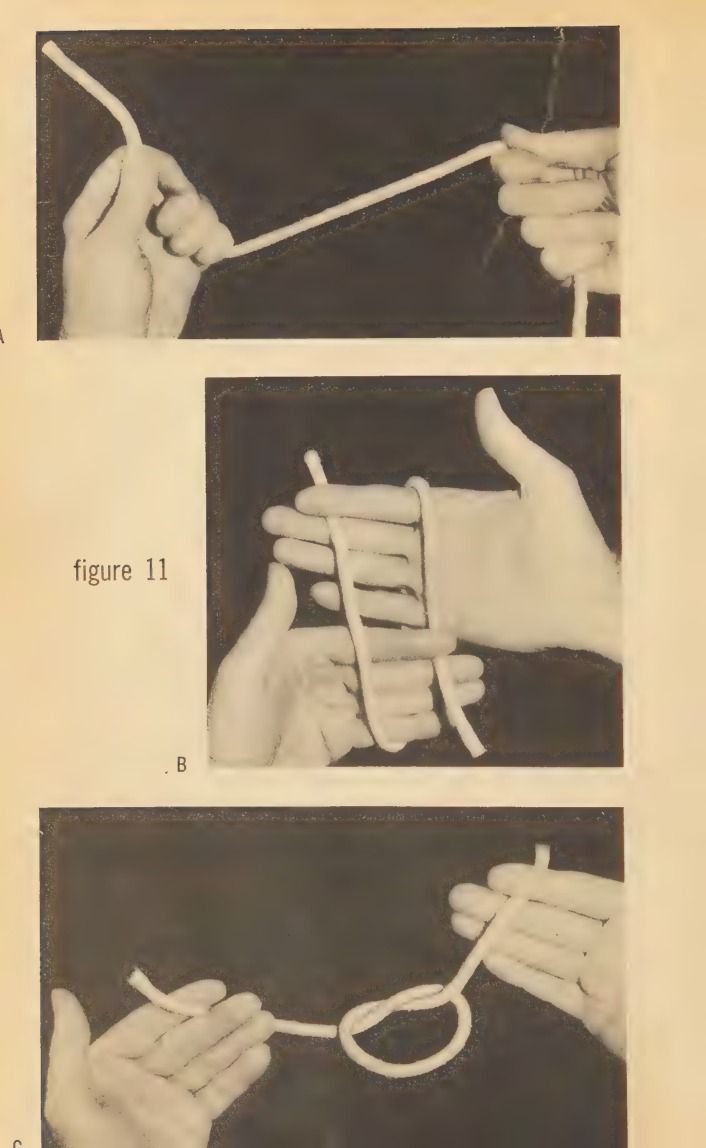
figure 11
1. The instantaneous knot
A knot is tied instantly.
Hold the rope as shown in fig. 11A. Bring the hands together. The right first and second fingers grasp the left end of the rope, the left first and second fingers grasp the right end (fig. 11B). Pull the hands apart fast. The knot will form at the center (fig. 11C). Bring the hands together and pull them apart as rapidly as possible.
2. The dissolving knot
Drop the left end of the, rope and grasp the knot with the left hand, inserting the first and second fingers into the knot (fig. 12). Bring the right end of the rope over to the knot and hold it between the tips of the left first and second fingers. Immediately take the left end of the rope in the right hand and pull it to the right. The knot will fall off the left fingers and apparently dissolve at the center of the rope.

figure 12 -
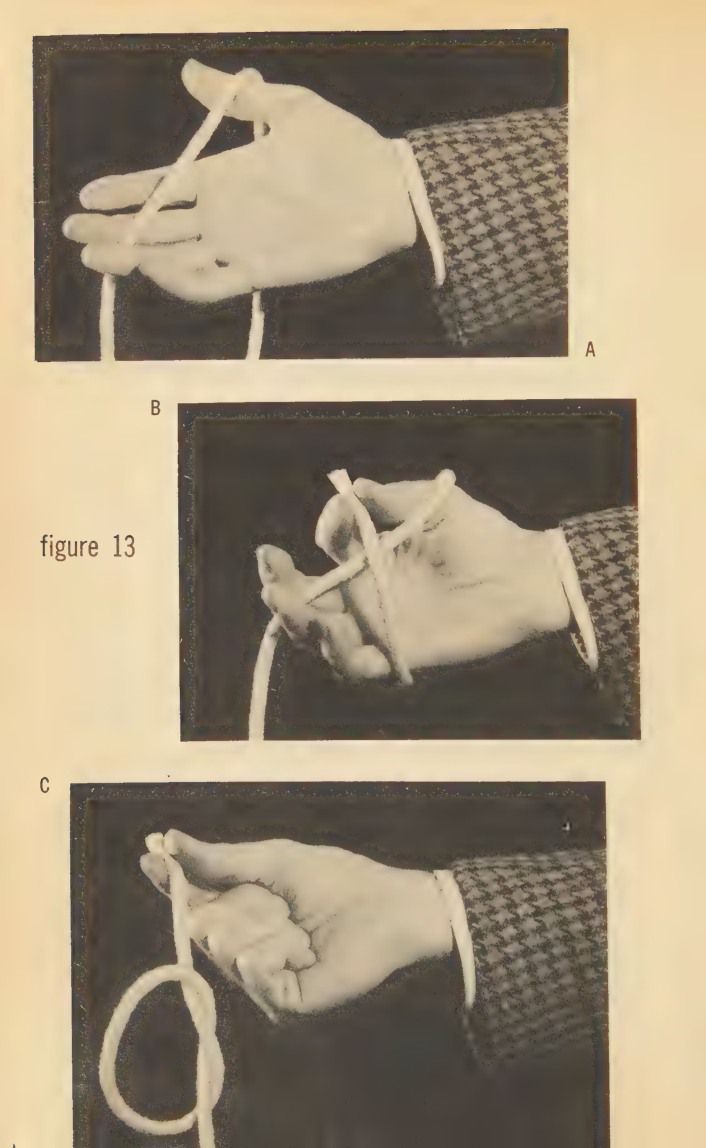
figure 13
3. One-hand instant knot
Hold the rope as in fig. 13A. Turn the hand palm down, then lower it quickly and catch the end of the rope that hangs behind the hand with the thumb and forefinger (fig. 13B). Let the loop around the hand fall off, forming a knot (fig. 13C). With a little practice for speed, you will find that a flick of the wrist seems to make the knot form by itself.
4. the comedy knot
An excellent opener for any series of rope tricks.
Prepare for this in advance by tying a good-sized knot at one end of your rope, then cut it off, and trim both ends close to the knot. Just before you begin the trick, finger-palm this knot in the right hand.
Display a rope about three feet in length and hold it as in fig. 14A. Twist the right fingers inward around the rope and then up behind the left fingers. Grasp the left-hand loop with the right fingers and the right-hand loop with the left fingers (fig. 14B). Pull the hands apart forming a knot (fig. 14C). Pull the knot tight (fig. 14D).
"This is a shoelace knot. And you all know what happens when one or both ends of your shoelaces become entangled in the loops." As you say this, push the right thumb and forefinger in through the loop from the side nearest you, pick up the end of the rope, and pull it through the loop. The left fingers do the same (fig. 14E).
"You get a knot that is extremely difficult to untie." Pull the ends of the rope until the two loops are so small that they become part of the central knot. Don't pull them all the way through because the knot will disappear.
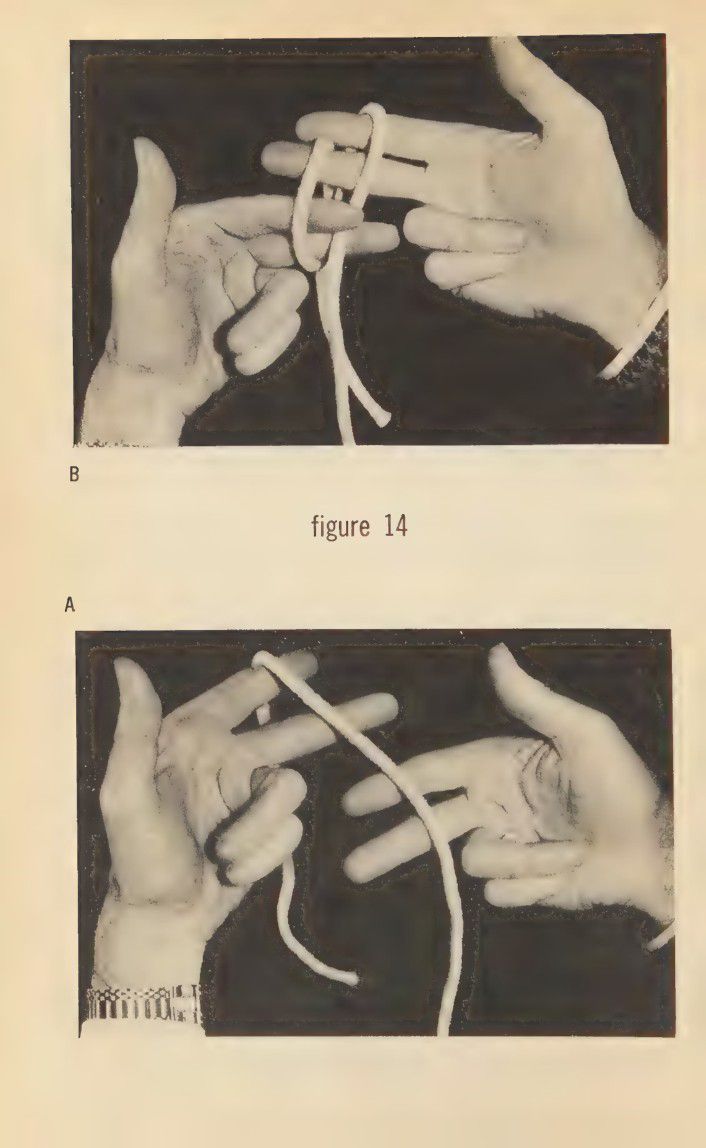
figure 14
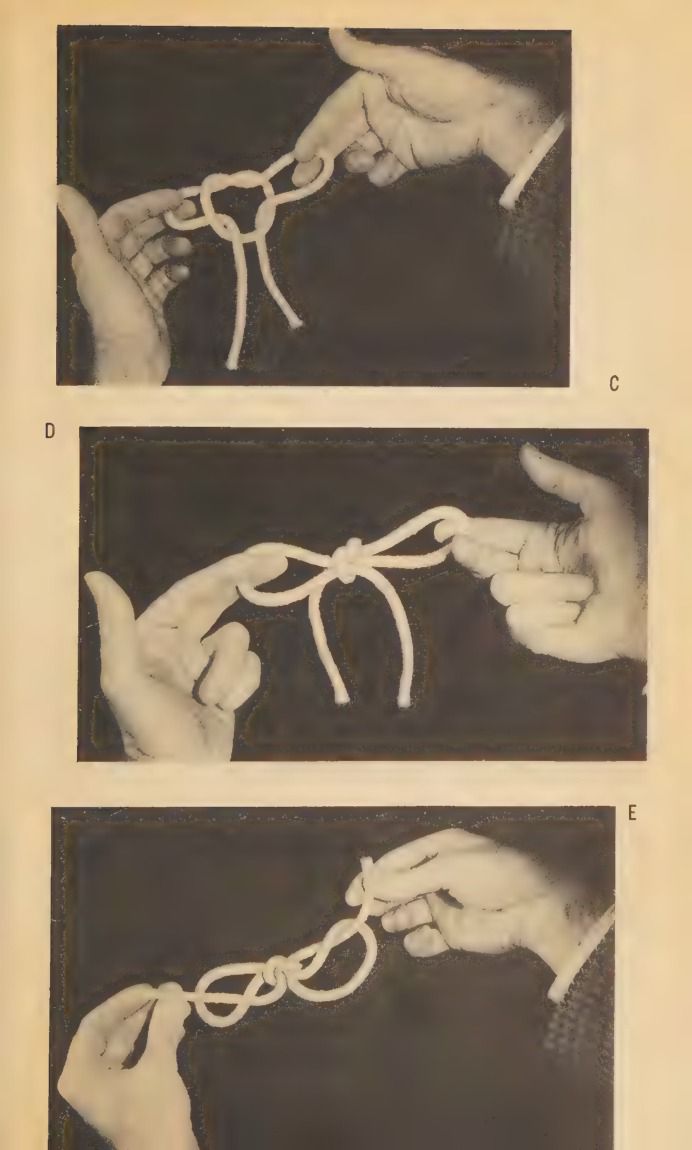
Now take both ends of the rope in the left hand. "Since it is almost impossible to untie this knot the best way to get rid of it is by magic. If I take it in my right hand and pull hard — the knot comes off the rope and I throw it away!" As you say this, cover the knot with your right fingers and pull. The knot will dissolve in your hand, and you toss the concealed knot to the spectators.
Follow immediately with this. Tie the same knot again, saying, "I should add a word of warning. When you tie this knot be sure that you dort do this." Put the ends through the loops as before, but put each end through twice. Make certain that the ends are always pushed through from the side away from you; otherwise you'll find that you really do have a knot. Pull, as before, until the loops become part of the central knot.
"If the ends go through the loops twice this gives you the famous Gordian knot which Alexander the Great had to cut. In fact, if there is anyone within the sound of my voice who can untie this knot without cutting the rope I will give him one hundred thousand . . ."
Just as you say "thousand" pull the ends of the rope. The knot vanishes. Look at the rope in surprise, then look at the spectators, frown, and add slowly, "What was I saying?"
5. The prisoner escapes
A quick, startling, and seemingly quite impossible escape from a rope tie which Houdini, the greatest of all escape artists, often used.
Rope, cord, or string may be used. Rope is best because it seems more secure and makes the escape look harder. You need two pieces: a short two-foot length and another about ten feet long.
Tell your audience that you are going to enact a TV Western, all live and in full color. "I need someone to play the part of Two-Gun Pete, the Terror of the Plains." When performing for children don't ever ask for volunteers; you'll be mobbed. Select an assistant and ask him, "Have you ever had any experience holding up stagecoaches?" You may get a "yes" to this, because most children know a lot more about this than you do.
Give him the longer rope. "This is your lasso. Our story starts just as you are holding up the stagecoach. You make one mistake, though. One of the passengers on this coach is Wyatt Earp. That's me." (If you're a woman you can be Annie Oakley.) "But Two-Gun Pete is such a fast man on the draw that he gets the drop on our hero and puts handcuffs on him. The prop man lost the handcuffs that we usually use on this show, but we can make a pair with this short piece of rope. Tie one end around my left wrist."
See that he ties several tight knots, the more the better. Have the other end tied around the right wrist in the same way.
"Now Pete throws one end of his lasso over the handcuffs, takes it again, and then holds both ends tightly" (fig. 15A).
"Pete mounts his horse and heads for his hideout in the mountains, with his prisoner walking along behind." Have your actor pretend to get on a horse, turn, and move away, his back toward you.
"Marshal Earp is in a tough spot, because Pete has taken his gun, and the United States Cavalry is two hundred miles away, surrounded by Indians. But Pete, who should know by now that the bad guy never wins, has a surprise coming.
When he reaches his hideout and turns around — his prisoner is no longer there!"
The escape is made during this speech, and at the end of it our hero (you) is still handcuffed, but is free of the lasso.
It's done this way. As you talk, turn your back to the audience, hiding your hands. Grasp the loop of the lasso and
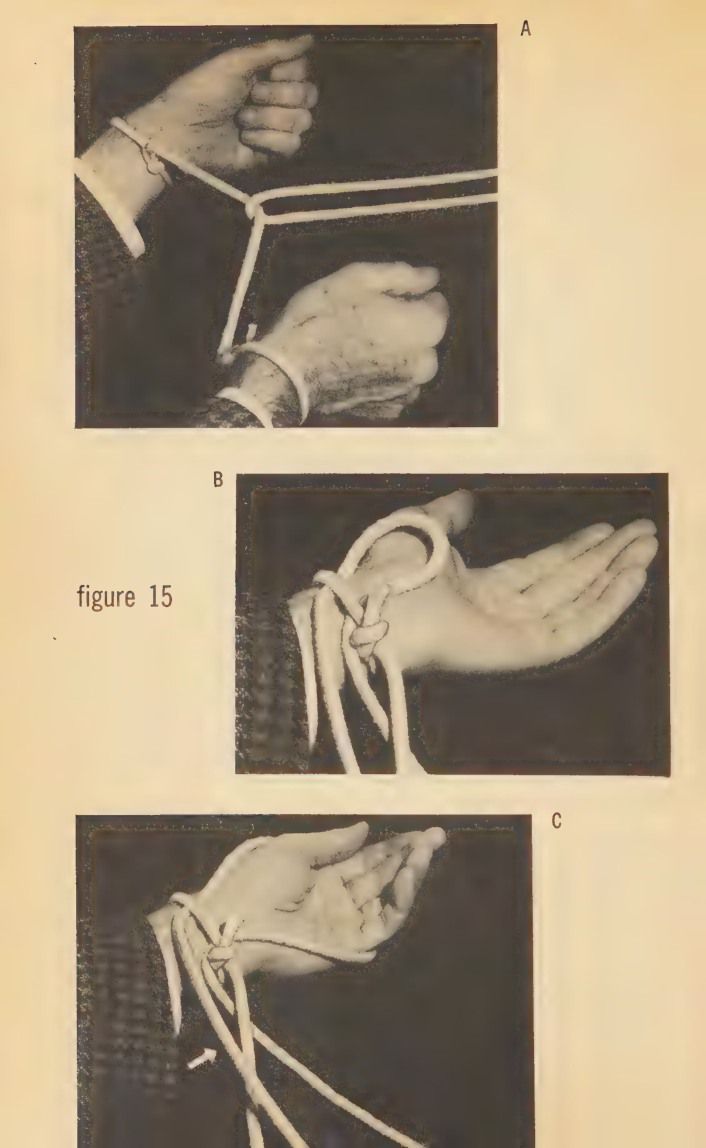
push it from the back under the circle of rope around the left wrist (fig. 15B). Then pull the loop out and over the left hand (fig. 15C). Grasp the rope at the point indicated by the arrow and pull the loop back under the circle around the wrist again — and you are free. Make the escape as quickly as possible because this makes it obvious that you couldn't have untied and retied the knots. The whole action can be done in a few seconds. As soon as you say, ". . . his prisoner is no longer there!" drop the lasso and step back. This one escape, because it looks so impossible and is accomplished so quickly, will make your reputation as an escape artist.
When you have learned the foregoing trick you have added three tricks to your repertoire simultaneously. The two that follow, although they look different, are accomplished by exactly the same means.
6. The mystic ring
The performer's wrists are tied as in the preceding trick, and a rubber Mason jar ring apparently penetrates the rope.
After escaping from the lasso, give the spectator a Mason jar ring. "Examine that and see if you can find any hole in it." When he fails, take the ring and say, "I don't know how you overlooked it. There's quite a large hole in the ring — right through the middle."
Turn your back, and push one hand through the ring. Slide the ring up the arm, passing it under the rope that encircles the wrist (fig. 16A). Then slide the ring down off the hand and over the rope. The ring now encircles the rope between the wrists (fig. 16B). Nothing could be simpler and yet it looks impossible.
Then take the ring off by reversing the procedure, and throw it out for examination.
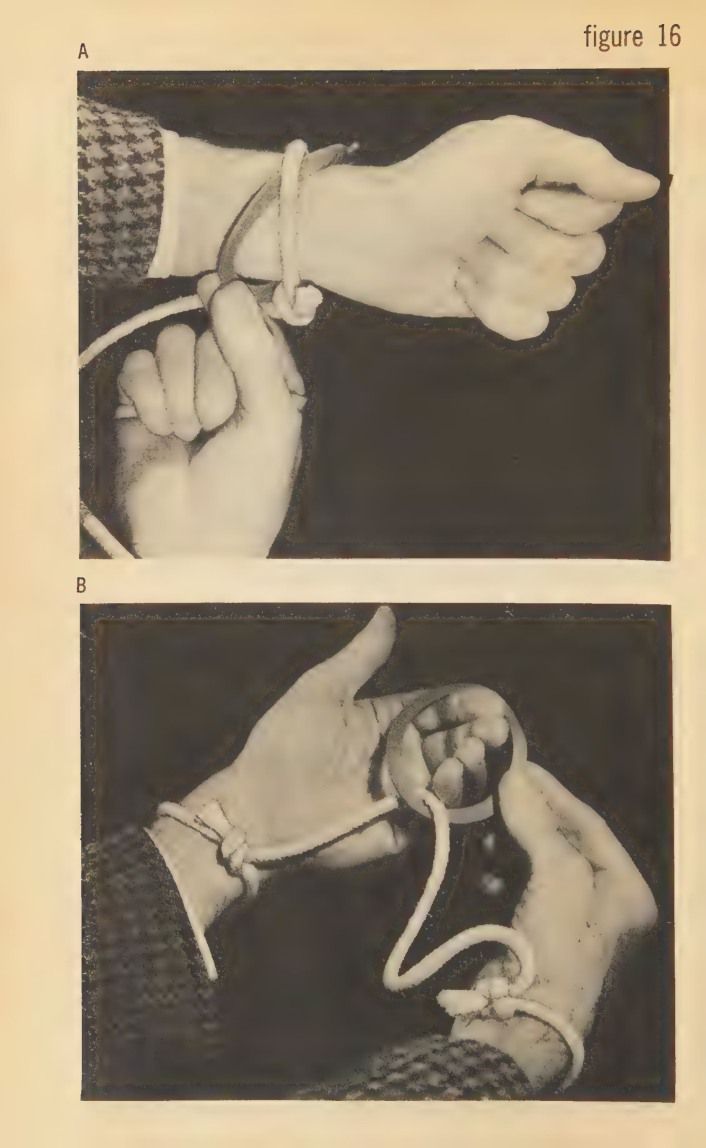
figure 16
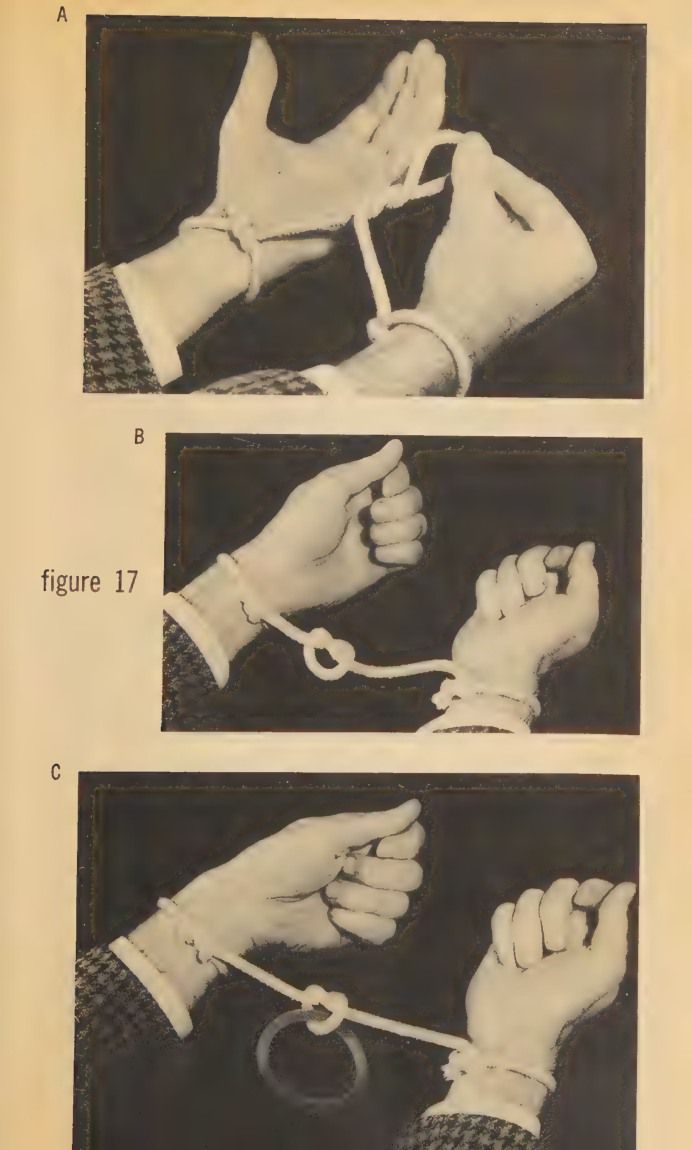
figure 17
7. the fourth-dimensional knot
A knot can also be tied on the center of the rope between the wrists.
Grasp the rope at the center and give it a triple twist, forming a loop (fig. 17A). Now follow the same procedure as used in freeing yourself of the lasso. Turn your back to the audience. Then push the loop under the rope around the left wrist, over the hand, back down on the outside of the wrist, under the rope again, and then over the hand. This forms a simple overhand knot in the center of the rope (fig. 17B).
If you give the rope an additional twist, the knot formed will be a figure eight.
As a final brain teaser to this series of penetrations, after tying the knot, take the rubber ring again. Place it on the rope as explained in The Mystic Ring, then slide it along the rope and into the knot (fig. 17C). This double impossibility seems to prove conclusively that the ring must have penetrated the rope at its center.
8. The world's most complicated knot
An extremely complicated-looking knot gets smaller and smaller and then vanishes.
Hold both ends of a three-foot rope in your left hand. Put your right hand under and through the loop at the bottom, and grasp both strands of the rope (fig 18A). Pull the rope to the right, forming a double loop (fig. 18B). Push both ends of the rope through both loops (fig. 18C). Take one end in each hand and pull the ends apart until the knot shown in fig. 18D forms.
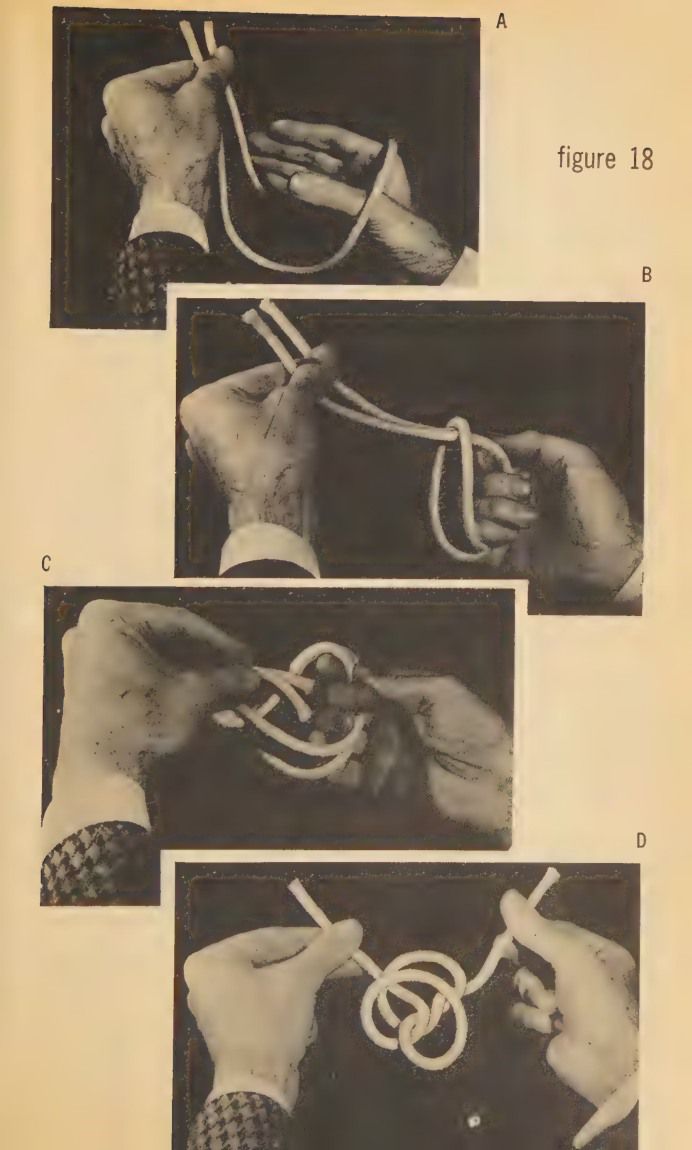
figure 18

figure 19
This is all done while you are saying, "Boys and girls, here is the world's most complicated knot — the double running bowline half-hitch."
Now pull the ends apart slowly as you say, "I spent ten years inventing this knot, but I still haven't found a good use for it." The knot gets smaller and smaller and then vanishes. Time this so that the knot vanishes just as you finish speaking.
9. Two knots at once
You apparently tie The World's Most Complicated Knot again, but this time you get an entirely different result.
Begin as before (figs. 18A and 18B). Push the loop nearest you through the other loop (fig. 19A). Then put one of the rope ends held by the left thumb and forefinger through both loops (fig. 19B). Pull the ends apart slowly. Two knots will form as in fig. 19C.
10. Visible penetration
A silk scarf visibly penetrates a rope.
Give a spectator a silk scarf, then form a double loop in your rope as in figs. 18A and 18B. Have the spectator thread the scarf through the double loop. Then ask him to tie the ends of the scarf together (fig. 20A). After he has done this, take one end of the rope in each hand and pull the ends apart forcibly with a quick jerk. This causes the rope to become straight, and transfers the double loop to the scarf (fig. 20B).
Give the rope to the spectator and ask him to hold it securely by the ends. "I am going to try to remove the scarf without touching the knots you tied." Grasp the scarf as
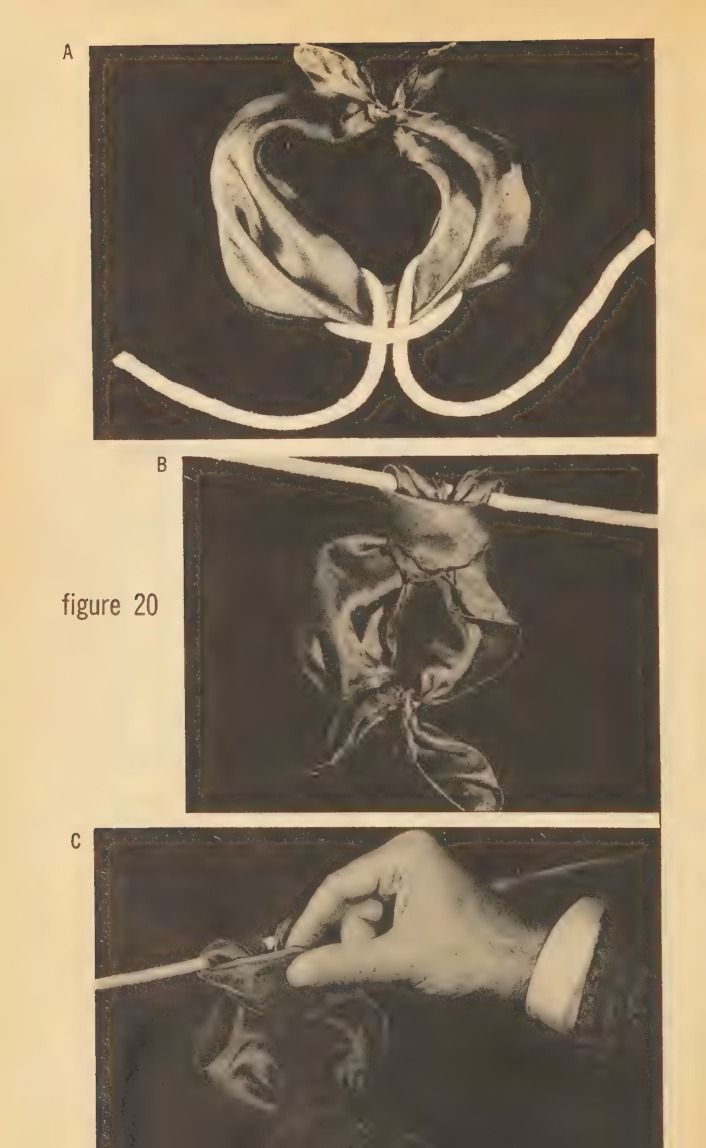
figure 20
shown in fig. 20C and pull until the knot loosens. Then - quickly pull the scarf down and away from the rope. It will appear to pass right through the rope. Display the scarf in a circle, showing that the knots tied by the spectator are still intact, and say, "Don't ask me how that is done. I have never been able to figure it out myself."
Bạn đang đọc truyện trên: Truyen4U.Com